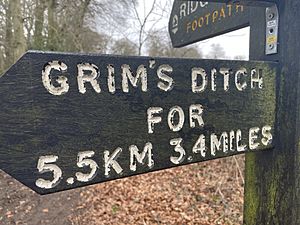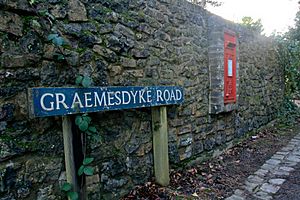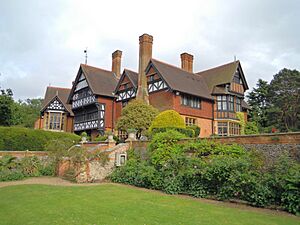Grim's Ditch facts for kids

Grim's Ditch is the name for many old earthworks found across southern England. These are like long banks and ditches dug into the ground a very long time ago. People also call them Grim's Dyke or Grim's Bank.
We don't know for sure why they were built, but they are too small to be used for fighting. Experts think they might have been used to mark out different areas or territories. Archaeologists believe people from the Iron Age built these earthworks around 300 BC. Today, some parts of Grim's Ditch are part of The Ridgeway, a famous long-distance walking path.
Contents
What Does the Name Mean?
The name "Grim's Ditch" comes from Old English, a language spoken long ago. The word dīc meant either a trench or the bank of soil dug out from it. This is why we now have the words ditch and dyke.
The "Grim" part of the name is a bit of a mystery! Many old earthworks in England and Wales were built long before the Anglo-Saxons arrived. When the Anglo-Saxons found these mysterious old structures, they often named them "Grim." Many experts think "Grim" comes from an Old Norse word, Grimr. This was another name for the Norse god of war and magic, Odin (also called Wōden). It means "the masked one."
Some historians believe that the Anglo-Saxons thought these earthworks were built by Wōden himself. Or, they might have been important places where people worshipped him. Since Wōden was a god of war, people might have thought these ditches were for military use.
Over time, as people in England became Christian, old gods like Wōden sometimes became linked with the Devil. This is why you can find other earthworks named after the Devil, like "Devil's Dyke." Many place names in Britain, like Grimsby or Grimsthorpe, are also linked to "Grim" or the Devil.
Where Are Grim's Ditches Found?
There are several famous Grim's Ditches across England.
Berkshire
In West Berkshire, there's a section about 5 kilometers long. It's on the Berkshire Downs, which is a chalky hillside.
Essex
In Colchester, there's a large earthwork called Gryme's Dyke. It's the longest of several ditches built in the late Iron Age. These ditches helped protect the important settlement of Camulodunum (Colchester). Gryme's Dyke is still visible today as a raised bank.
Hampshire
One ditch in Hampshire covers an area of about 16 square kilometers. It runs for about 14 kilometers and has two banks with a ditch in between. Experts think this Grim's Ditch might be from the Bronze Age or early Iron Age. Another smaller ditch is found in west Hampshire, near the villages of Upton and Netherton.
Oxfordshire
The South Oxfordshire ditch is about 5 kilometers long. It runs from Mongewell near the River Thames to Hayden Farm. When parts of it were dug up for the Winterbrook Bridge, they found it was from the late Iron Age or early Roman period. This ditch has a bank on its north side. This suggests it was meant to stop people from easily entering the southernmost part of Oxfordshire.
There's also another set of features called Grim's Dyke in West Oxford. You can see it as a shallow ditch and a raised area in the woods near North Leigh and Stonesfield.
Chilterns
The Chilterns ditch starts at Bradenham and stretches for about 30 kilometers north to Ivinghoe. Its size changes a lot along its path. We're not sure what its exact purpose was, and different parts might have been used for different things. Parts of this earthwork can still be seen on Berkhamsted Common and in Potten End.
Harrow
Grim's Ditch in Harrow (also called Grim's Dyke) is about 3 kilometers long. It stretches from Harrow Weald to Bushey Heath on the edge of Greater London. It might have been built by the Catuvellauni tribe to defend against the Romans.
A large house built in 1870-72, called Grim's Dyke, was named after these earthworks. This beautiful Victorian mansion used to be the home of the famous writer W. S. Gilbert. Today, it is a hotel.
Locations Map





